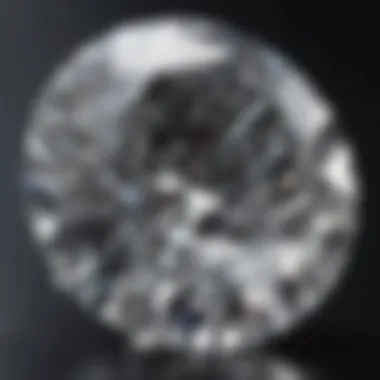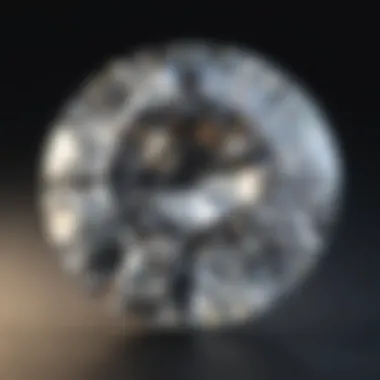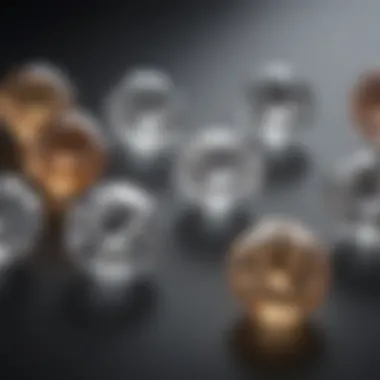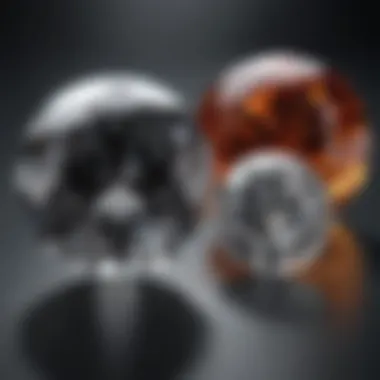Mastering Round Diamond Cut Proportions for Value


Intro
Round diamonds have captivated hearts for centuries with their brilliance and charm. However, the true allure of a round diamond lies hidden within its cut proportions. This article will unfold the essential aspects of round diamond cut proportions, examining how they affect the diamond's beauty, brilliance, and market value.
To appreciate these nuances and their implications, we will explore the fundamental characteristics of diamond cuts, highlight the specific proportions that influence aesthetics, and discuss the technical evaluations involved. By doing so, we aim to empower consumers, collectors, and jewelry designers with knowledge that aids them in making informed decisions in the fascinating world of round diamonds.
Gemstone Overview
Description of the gemstone
Diamonds are formed under extreme pressure and temperature deep within the Earth’s mantle. They are composed of carbon atoms, arranged in a crystal lattice structure. This unique arrangement leads to their exceptional hardness and ability to refract light brilliantly. Among various diamond shapes, the round cut is the most popular. Its circular symmetry maximizes light performance, making it a preferred choice for engagement rings and other fine jewelry.
Physical properties
Diamonds possess several notable physical properties:
- Hardness: Rated 10 on the Mohs scale, diamonds are the hardest known natural material.
- Refractive Index: The refractive index of diamonds is approximately 2.42, allowing them to reflect light effectively.
- Dispersion: Diamonds exhibit a high level of dispersion, resulting in the dazzling rainbow colors often seen in well-cut diamonds.
- Specific Gravity: Diamonds have a specific gravity of about 3.5, making them relatively dense compared to other gemstones.
Understanding these properties is essential, as they underlie the importance of cut proportions, which will be further explored in the following sections.
"The cut of a diamond is crucial; it determines how light interacts with the diamond, influencing both beauty and value."
Importance of Cut Proportions
Cut proportions play a pivotal role in a diamond's overall appearance. The right proportions enhance light performance, ensuring that the diamond sparkles and shines in any light. Factors such as table size, crown angle, and pavilion depth must be balanced to achieve brilliant results.
Key Proportions to Consider
- Table Percentage: Refers to the width of the diamond's table relative to its diameter. An ideal range is often between 53% to 60%.
- Crown Angle: The angle at which the crown facets meet the girdle. An angle around 34 to 35 degrees is considered optimal for maximum brilliance.
- Pavilion Depth: The depth of the pavilion facets also affects light return. An ideal depth generally falls between 40.5% to 42.5%.
In the subsequent sections, we will delve deeper into these aspects, highlighting their significance and implications for diamond shoppers and enthusiasts.
Prolusion to Round Diamonds
Round diamonds have long captivated the hearts and minds of consumers and collectors alike. The significance of the round diamond cut extends beyond mere aesthetics; it embodies a fusion of historical context, technical precision, and a deep-rooted cultural affinity for brilliance. As we delve into the world of round diamonds, we must consider various elements such as design proportions, light performance, and market dynamics that shape their desirability.
Historical Context
The journey of round diamonds began centuries ago when jewelers sought to maximize the stone's ability to reflect light. The first recorded instance of a round diamond cut can be traced back to the Renaissance period. During this era, jewelers applied rudimentary techniques to create forms that enhanced diamond's natural properties. With the advent of the modern brilliant cut in the late 19th century, round diamonds revolutionized the industry. This intricate cut allowed for improved sparkle and visual appeal.
Over the decades, cutting technology has evolved remarkably. The introduction of computer-aided design (CAD) and advanced machinery has enabled precision never before seen. Today, historical techniques combined with cutting-edge technology ensure that round diamonds come with ideal proportions that enhance their aesthetic qualities. This rich history contributes to the allure of round diamonds, making them a timeless choice for various occasions.
Significance of Round Cuts
The round cut holds a prominent place in the market for several reasons. Firstly, the shape itself is inherently versatile. It complements different settings and styles, from classic solitaires to intricate vintage designs. Round diamonds also tend to outperform other shapes when it comes to maximizing light return. With appropriate proportions, such as crown angle and table percentage, a well-cut round diamond achieves an exceptional level of brilliance.
Moreover, round diamonds maintain their status in the luxury market, symbolizing commitment and love. These cuts often represent traditional engagements and anniversaries, thus embedding themselves in cultural practices worldwide. As consumers become increasingly discerning, understanding the importance of round cuts in terms of quality, brilliance, and market value solidifies their appeal. In essence, round diamonds encapsulate not just beauty but also the significant investment consumers make in them.
"Understanding round diamond proportions and cuts is essential; it not only enhances appreciation but also guides purchasing decisions."
In summary, the niche of round diamonds extends far beyond their physical attributes. The historical evolution and significance highlight their position as a premier choice in the jewelry landscape. This understanding leads into deeper exploration of diamond cuts and their various proportions, which shall unfold in the following sections.
Understanding Diamond Cuts


Understanding diamond cuts is vital in the discussion of round diamond cut proportions. It provides the foundation for discerning the methods and artistry involved in crafting a diamond. Diamonds undergo intricate transformations from rough stones into brilliant, polished gems. The cut, which includes shape and facets, plays a crucial role in determining a diamond's overall appearance, light performance, and ultimately its value. An informed understanding of these cuts ensures collectors and consumers make choices that reflect their aesthetic preferences and investment goals.
What is a Diamond Cut?
A diamond cut refers to the style and quality of the diamond's physical shape and the arrangement of its facets. This aspect significantly influences how the stone interacts with light. A well-executed diamond cut can enhance a diamond's brilliance and fire. Conversely, a poor cut can diminish its visual appeal, making it appear dull. The craftsmanship involved in cutting the diamond ensures that proportions are executed wisely, emphasizing its beauty.
Types of Cuts
The world of diamond cutting encompasses various styles. Each cut has its specific characteristics, aimed at accentuating the diamond's unique qualities.
Brilliant Cut
The Brilliant Cut is notable for its numerous facets, maximizing light reflection and enhancing brilliance. This type of cut is exceptionally popular due to its ability to produce stunning visual effects. The key characteristic of the Brilliant Cut lies in its 58 facets, which are precisely arranged to compound light performance. A well-executed Brilliant Cut can effectively mask flaws, making it a beneficial choice for achieving optimal sparkle. However, it may require higher-quality rough stones due to the significant material loss during the cutting process.
Princess Cut
The Princess Cut is recognized for its contemporary appeal and square shape. This cut blends the brilliance of a round cut with the angular beauty of a square. One of its key characteristics is its ability to maximize carat weight, allowing for larger appearances in smaller sizes. The unique feature of the Princess Cut is its well-defined corners, giving it a striking visual impact. However, its angular nature can make it slightly more susceptible to chipping when compared to round cuts, which is a consideration for buyers concerned with durability.
Emerald Cut
The Emerald Cut differs markedly from other styles, focusing more on clarity and light rather than brilliance. This cut features a rectangular shape with step facets that provide a hall of mirrors effect. The key characteristic of the Emerald Cut is its long lines and geometric appearance, which creates a sophisticated silhouette. This cut is a beneficial choice for those who appreciate internal clarity and the gemstone's color. On the downside, it may not offer the same level of sparkle as a Brilliant or Princess Cut, appealing more to those with a refined taste for elegance over flash.
No single cut can claim superiority. Instead, each cut brings its own allure, catering to diverse preferences in the jewelry market.
Proportions of Round Diamond Cuts
Understanding the proportions of round diamond cuts is crucial in grasping their overall value and visual appeal. Proportions determine how light interacts with the diamond, significantly affecting its brilliance and appearance. Consumers and collectors often overlook these details, but a proper knowledge of proportions can lead to more informed decisions. Finding the right balance of proportions can enhance the beauty of a gemstone while also impacting its market value significantly.
Key Proportions
Crown Angle
The crown angle is a fundamental aspect of a diamond's configuration. It is the angle between the table (top flat surface) and the facet of the crown above. An appropriate crown angle usually ranges from 34 to 36 degrees. This angle is essential for maximizing light return, leading to higher brilliance.
A key characteristic of a well-defined crown angle is its direct influence on how light enters and exits the diamond. A steeper angle may cause light to leak out of the sides, while a shallower angle might lead to a dull appearance. Because of this, many buyers prefer diamonds with an optimal crown angle, enhancing both beauty and perceived value.
However, the crown angle has disadvantages. If it is too steep, it could lead to a "fish-eye" effect where the lower part of the diamond appears dark. Thus, careful consideration of the crown angle is vital in the selection process.
Pavilion Depth
Pavilion depth is another critical proportion. This depth measures from the bottom of the diamond to the end of the pavilion. An ideal pavilion depth generally falls between 43% and 45% of the total depth of the diamond. This measurement directly relates to the diamond's ability to manipulate light.
A well-proportioned pavilion depth allows for optimal light reflection and refraction, giving rise to the diamond's fire and brilliance. In high-quality diamonds, this depth contributes to the overall aesthetic appeal. However, too deep of a pavilion can absorb light, diminishing sparkle. Conversely, a shallow pavilion can also lead to dullness due to ineffective light reflection.
Table Percentage
The table percentage refers to the size of the table facet as a proportion of the total diameter of the diamond. An ideal range for table percentage is 53% to 58%. This figure is crucial in ensuring that the diamond maintains the right balance between brilliance and fire.
The table percentage plays a pivotal role in how light enters the diamond. A larger table can increase light entry but might also sacrifice depth and brilliance. On the other hand, a smaller table can enhance brilliance but may limit light entry, resulting in a normal appearance. Therefore, selecting an ideal table percentage is essential for achieving the desired visual impact.
Ideal Proportions
The ideal proportions are those metrics that most closely align with the target characteristics of a round diamond. When selecting a diamond, adherence to these proportions often distinguishes high-quality stones from merely acceptable ones. Many experts agree that diamonds achieving ideal proportions in crown angle, pavilion depth, and table percentage will demonstrate the best overall performance in terms of light return and visual appeal.


To summarize, understanding the key proportions—crown angle, pavilion depth, and table percentage—is essential for anyone interested in round diamonds. By grasping these guidelines, consumers can enhance their selections, ensuring they are acquiring stones with not only aesthetic beauty but also value.
Evaluating Proportions
Evaluating the proportions of round diamond cuts is a key aspect of understanding their overall quality and aesthetic appeal. In this section, we will explore the various grading systems which offer clear frameworks for assessing these proportions. Knowledge of proportions helps consumers make informed decisions in the purchase process. Buyers gain insights into not just the visual beauty of the diamond, but also how these characteristics translate into market value.
In the realm of diamonds, proportions can include factors such as the angle of the crown, the depth of the pavilion, and the size of the table. These measurements significantly influence how light interacts with the stone, contributing to its brilliance and fire. Understanding how to evaluate these proportions can lead to a more satisfying purchase experience and greater appreciation for the jewel’s intrinsic qualities.
Grading Systems
Grading systems serve as standardized methods for evaluating the quality of round diamond cuts. They provide an easily navigable approach for consumers. The two most recognized grading organizations in the diamond industry are the Gemological Institute of America (GIA) and the American Gem Society (AGS). Each has methodologies designed to offer an informed perspective on diamond quality.
GIA
The GIA is widely considered the authority in diamond grading. Its comprehensive analysis includes detailed examination of the cut, color, clarity, and carat weight. The GIA's grading system is recognizable and trusted by both consumers and retailers. A particular advantage of the GIA is its rigorous training protocols, which ensure that all graders adhere to defined standards. This helps maintain consistency in evaluations.
A unique feature of the GIA's grading is the Focus on the overall cut quality. This involves an assessment that incorporates various proportions, such as crown angle and pavilion depth. Its grading results often influence market values significantly. However, the complexity of its reports may be seen as a disadvantage for some consumers who prefer simpler summaries.
AGS
The AGS also plays an essential role in diamond grading. It focuses more on the cut quality, often emphasizing how well the diamond performs in terms of light reflection. AGS employs a cut grade scale which ranges from 0 to 10, with lower numbers indicating better performance. One key characteristic of AGS grading is its advanced technology for assessing light performance, which many find appealing.
A notable feature of the AGS is its ability to deliver detailed reports that prioritize the visual aspects of the diamond. This characteristic suits discerning buyers who value the performance attributes of their stones. Nevertheless, some critics argue that the AGS system lacks widespread recognition compared to GIA.
Understanding Grade Scores
Grade scores represent a numeric or descriptive rating given to the proportions of a round diamond cut. This scoring offers valuable insights into the balance and alignment of the diamond's facets. High score ratings generally indicate excellent light performance and overall quality.
Grading encourages consumers to consider what aspects are most essential to them. Different buyers may prioritize brilliance over symmetry, impacting their choices significantly. In navigating this information, it is essential for consumers to grasp how grade scores correlate with their preferences and expectations.
Impact of Proportions on Appearance
The proportions of a round diamond play a pivotal role in determining its aesthetic appeal. These metrics not only affect how a diamond reflects light but also contribute to its overall visual beauty. Understanding this impact is essential for anyone involved in the diamond market. Incorrect proportions can misalign a diamond's characteristic light performance, leading to less brilliance, fire, and sparkle. Therefore, evaluating the proportions is a fundamental part of selecting a diamond that meets one's expectations in beauty.
Light Performance
Light performance is a term used to describe how well a diamond interacts with light. It encompasses three main aspects: brilliance, fire, and sparkle. Each of these aspects is vital in creating the overall effect that a diamond has. A diamond that excels in light performance tends to showcase a stronger allure and deeper color richness.
Brilliance
Brilliance refers to the amount of white light that a diamond reflects. The higher the brilliance, the more lively the diamond appears. This is a key characteristic because it not only enhances the visual appeal but also signifies quality. A diamond with high brilliance is often preferred by buyers for its dazzling effect. The cut and proportions influence how much light enters the diamond and how efficiently it is reflected. However, too much focus on achieving extreme brilliance can sometimes lead to overexposed areas, diminishing the diamond's overall aesthetic rather than enhancing it.
Fire
Fire is the colorful flashes of light that emerge as a diamond moves. This effect occurs when light splits into its spectral colors, creating an illusion of colored sparks. This is a defining characteristic of high-quality diamonds, making them highly sought after. When light performance is strong, the fire becomes more visible, thus enhancing beauty. However, if the proportions are off or if the diamond is poorly cut, the fire can be lackluster. Hence, understanding fire and its proportional relationships is essential for buyers looking for stunning diamonds.
Sparkle
Sparkle is the lively flashes of light seen when the diamond is moved. This aspect is influenced by the diamond's overall cut and proportions. A diamond exhibiting excellent sparkle will catch the eye while in motion, drawing attention with every turn. This effect is highly valued in diamond selection, as it gives a sense of liveliness and dynamism. On the other hand, inadequate proportions can lead to a dull appearance, resulting in a less attractive appearance.
Visual Symmetry
Visual symmetry refers to the consistent and balanced appearance of a diamond when viewed from different angles. It plays a critical role in the perception of beauty. A well-proportioned diamond appears uniform and harmonious, creating an air of sophistication. Potential buyers often search for diamonds that exhibit high visual symmetry because they tend to look more appealing. The craftsmanship involved in achieving visual symmetry is significant, as it requires precise cutting and shaping to create the desired effect. In summary, understanding the importance of visual symmetry can guide consumers in making informed choices while searching for the perfect diamond.


Market Value Considerations
In the realm of round diamonds, understanding the factors that contribute to market value is vital. Market value encompasses various elements that impact a diamond’s price and desirability. Among these, proportions, carat weight, and color and clarity play significant roles. Each aspect is intricately connected to a diamond's aesthetic appeal and its perceived worth by consumers. Knowledge of these considerations enables buyers to make well-informed decisions when selecting a diamond.
Conditions Affecting Value
Proportions
The proportions of a round diamond are often a primary determinant of its overall beauty and market value. Key proportions, including crown angle, pavilion depth, and table percentage, can significantly influence how a diamond refracts light.
A well-proportioned diamond will exhibit optimal brilliance, fire, and sparkle. This key characteristic makes understanding proportions essential for both buyers and sellers. A diamond with ideal proportions often commands a higher price due to its superior performance in light interactions.
One unique feature of proportions is the balance they provide. A well-balanced diamond will ensure the light is directed back to the viewer, enhancing its visual appeal. However, an imbalance in proportions can lead to dull appearances and lower market value. Thus, consumers are encouraged to prioritize ideal proportions when making purchases.
Carat Weight
Carat weight refers to the measure of a diamond's size. This specific characteristic plays a critical role in determining a diamond's value. Larger diamonds typically command higher prices, evidenced by consumer demand for bigger stones. However, it is essential to note that carat weight is not the sole factor influencing price; it must be considered alongside quality elements like cut, color, and clarity.
One unique feature of carat weight is its correlation with consumer preferences. As consumers often associate larger diamonds with status and luxury, there is a perception that size equals value. Yet, larger diamonds may also result in higher costs without guaranteeing exceptional quality. Hence, understanding the interplay between carat weight and overall quality is paramount for discerning buyers.
Color and Clarity
Color and clarity significantly impact a diamond’s appearance and market value. Color grading assesses the presence of any hues in a diamond, while clarity grading evaluates the presence of imperfections. Diamonds that are clearer and more colorless tend to be more valuable.
A notable characteristic of color and clarity is their direct association with rarity. Higher quality diamonds in terms of color and clarity are rarer and more sought after, thus commanding higher market prices. This contributes to a diamond's overall prestige among collectors and enthusiasts.
The unique feature here lies in the balance. While some consumers prioritize color and clarity, others may focus on cut and proportions. Understanding personal preferences can drive informed decision-making.
Trends in Consumer Preferences
Consumer preferences continue to evolve in the diamond market. Recently, there has been an increasing inclination towards sustainable and ethically sourced diamonds. Buyers are starting to favor brands that convey transparency in sourcing materials. Additionally, unique shapes and custom designs are becoming more popular as consumers seek personalized pieces. Understanding these trends allows sellers to align their offerings with market demands, ultimately influencing value perceptions.
Common Misconceptions
Common misconceptions surrounding round diamond cut proportions can create significant misunderstanding among consumers and enthusiasts. It is vital to address these misconceptions to empower individuals with accurate knowledge. This knowledge ensures informed decisions when purchasing or evaluating round diamonds.
Cut Quality vs. Proportions
Many people conflate cut quality with proportions. While proportions are an essential element of a diamond's cut, they are not the sole determinant of its overall quality. The cut quality also considers craftsmanship, symmetry, and polish. A diamond can possess ideal proportions but lack fine workmanship, diminishing its brilliance.
Furthermore, cut quality significantly influences a diamond's ability to reflect light. For instance, if the crown angle is too steep or the pavilion is too deep, the diamond may end up appearing dull. This is a fundamental aspect to understand as it highlights how proportions can interact with other factors that contribute to the overall quality of a diamond. Consumers should not focus solely on numeric measurements but should also consider expert evaluations from recognized grading systems like GIA and AGS.
Luxury and Cost
There is a prevalent belief that a higher cost automatically translates to luxury and superior quality in round diamonds. While price often reflects quality, factors like rarity, demand, and market trends also play critical roles. For example, a diamond with perfect proportions but average color or clarity may not command the same price as a diamond with near-perfect clarity or color, regardless of cut.
Moreover, many consumers equate larger carat weight to higher value, overlooking the importance of proportions. A smaller diamond with superb proportions can outperform a larger diamond with poor cut quality in terms of appearance and, sometimes, even market value. This is a significant consideration for collectors and jewelry designers who often seek beauty and brilliance in addition to size.
Culmination
Final Thoughts on Round Diamonds
Round diamonds, popular for their timeless elegance, owe much of their appeal to specific cut proportions. A diamond's crown angle, pavilion depth, and table percentage can greatly enhance its visual characteristics. Understanding these proportions allows enthusiasts to better appreciate the craftsmanship involved in a well-cut diamond. Additionally, recognizing the importance of these metrics can lead to more satisfying purchases, ultimately improving customer experience in the jewelry market.
Encouragement for Informed Choices
Informed choices go beyond just selecting a visually appealing stone. It involves understanding the implications of different proportions on a diamond's performance and value. By equipping themselves with knowledge about round diamond cuts, consumers can navigate the intricate nuances of the market. This awareness is crucial for making wise investments, whether for personal adornment or as a collector's item.
As the market continues to evolve, the importance of diamond cut proportions remains foundational. Enthusiasts and collectors alike should take the time to learn about the craft behind these gemstones, ensuring they can appreciate and select diamonds with confidence.







